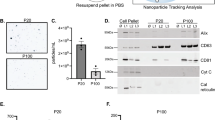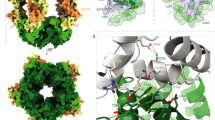Abstract
Glial-cell-line-derived neurotrophic factor (GDNF) and neurturin (NTN) are two structurally related, potent survival factors for sympathetic, sensory and central nervous system neurons1,2,3,4,5,6. GDNF mediates its actions through a multicomponent receptor system composed of a ligand-binding glycosyl-phosphatidylinositol (GPI)-linked protein (designated GDNFR-α) and the transmembrane protein tyrosine kinase Ret7,8,9,10,11,12. In contrast, the mechanism by which the NTN signal is transmitted is not well understood. Here we describe the identification and tissue distribution of a GPI-linked protein (designated NTNR-α) that is structurally related to GDNFR-α. We further demonstrate that NTNR-α binds NTN (Kd ∼ 10 pM) but not GDNF with high affinity; that GDNFR-α binds to GDNF but not NTN with high affinity; and that cellular responses to NTN require the presence of NTNR-α. Finally, we show that NTN, in the presence of NTNR-α, induces tyrosine-phosphorylation of Ret, and that NTN, NTNR-α and Ret form a physical complex on the cell surface. These findings identify Ret and NTNR-α as signalling and ligand-binding components, respectively, of a receptor for NTN and define a novel family of receptors for neurotrophic and differentiation factors composed of a shared transmembrane protein tyrosine kinase and a ligand-specific GPI-linked protein.
This is a preview of subscription content, access via your institution
Access options
Subscribe to this journal
Receive 51 print issues and online access
$199.00 per year
only $3.90 per issue
Buy this article
- Purchase on Springer Link
- Instant access to full article PDF
Prices may be subject to local taxes which are calculated during checkout





Similar content being viewed by others
References
Lin, L. H., Doherty, D. H., Lile, J. D., Bektesh, S. & Collins, F. GDNF: A glial cell line-derived neurotrophic factor for midbrain dopaminergic neurons. Science 260, 1130–1132 (1993).
Kotzbauer, P. T.et al. Neurturin, a relative of glial-cell-line-derived neurotrophic factor. Nature 384, 467–470 (1996).
Henderson, C. E.et al. GDNF: A potent survival factor for motoneurons present in peripheral nerve and muscle. Science 266, 1062–1064 (1994).
Buj-Bell, A., Buchman, V. L., Horton, A., Rosenthal, A. & Davies, A. M. GDNF is an age-specific survival factor for sensory and autonomic neurons. Neuron 15, 821–828 (1995).
Arenas, E., Trupp, M., Akerud, P. & Ibáñez, C. F. GDNF prevents degeneration and promotes the phenotype of brain noradrenergic neurons in vivo. Neuron 15, 1465–1473 (1995).
Trupp, M.et al. Peripheral expression and biological activities of GDNF, a new neurotrophic factor for avian and mammalian peripheral neurons. J. Cell Biol. 130, 137–148 (1995).
Takahashi, M., Ritz, J. & Cooper, G. M. Activation of a novel human transforming gene, ret, by DNA rearrangement. Cell 42, 581–588 (1985).
Takahashi, M. & Cooper, G. M. ret Transforming gene encodes a fusion protein homologous to tyrosine kinases. Mol. Cell. Biol. 7, 1378–1385 (1987).
Treanor, J. J. S.et al. Characterization of a multicomponent receptor for GDNF. Nature 382, 80–83 (1996).
Jing, S.et al. GDNF-induced activation of the ret protein tyrosine kinase is mediated by GDNFR-α, a novel receptor for GDNF. Cell 85, 1113–1124 (1996).
Trupp, M.et al. Functional receptor for GDNF encoded by the c-ret proto-oncogene. Nature 381, 785–789 (1996).
Durbec, P.et al. GDNF signalling through the Ret receptor tyrosine kinase. Nature 381, 789–793 (1996).
Koke, J. A., Yang, M., Henner, D. J., Volwerk, J. J. & Griffith, O. H. High-level expression in Escherichia coli and rapid purification of phosphatidylinositol-specific phospholipase C from Bacillus cereus and Bacillus thuringiensis. Protein Expr. Purif. 2, 51–58 (1991).
Ikeda, I.et al. Specific expression of the ret proto-oncogene in human neuroblastoma cell lines. Oncogene 5, 1291–1296 (1990).
Takahashi, M., Buma, Y. & Taniguchi, M. Identification of the ret proto-oncogene products in neuroblastoma and leukemia cells. Oncogene 6, 297–301 (1991).
Davis, S.et al. Released form of CNTF receptor α component as a soluble mediator of CNTF responses. Science 259, 1736–1739 (1993).
Schuchardt, A., D'Agati, V., Larsson-Blomberg, L., Costantini, F. & Pachnis, V. Defects in the kidney and enteric nervous system of mice lacking the tyrosine kinase receptor Ret. Nature 367, 380–383 (1996).
Durbec, P. L., Larsson-Blomberg, L. B., Schuchardt, A., Costantini, F. & Pachnis, V. Development 122, 349–358 (1996).
Pichel, J. G.et al. Defects in enteric innervation and kidney development in mice lacking GDNF. Nature 382, 73–76 (1996).
Sánchez, M. P.et al. Renal agenesis and the absence of enteric neurons in mice lacking GDNF. Nature 382, 70–73 (1996).
Moore, M. W.et al. Renal and neuronal abnormalities in mice lacking GDNF. Nature 382, 76–79 (1996).
Lindsay, R. M. & Yancopoulos, G. D. GDNF in a bind with known orphan: Accessory implicated in new twist. Neuron 17, 571–574 (1996).
Ip, N. Y.et al. CNTF and LIF act on neuronal cells via shared signaling pathways that involve the IL-6 signal transducing receptor component gp130. Cell 69, 1121–1132 (1992).
Wrana, J. L., Attisano, L., Wieser, R., Ventura, F. & Massague, J. Mechanism of activation of the TGF-β receptor. Nature 370, 341–347 (1994).
Lee, J.-D.et al. Glycosyl-phosphatidylinositol-anchored or integral membrane forms of CD14 mediate identical cellular responses to endotoxin. Proc. Natl Acad. Sci. USA 90, 9930–9934 (1993).
Pugin, J.et al. Lipopolysaccharide (LPS) activation of human endothelial and epithelial cells is mediated by LPS binding protein and soluble CD14. Proc. Natl Acad. Sci. USA 90, 2744–2748 (1993).
Hochuli, E., Dobeli, H. & Schacher, A. New metal chelate adsorbent selective for proteins and peptides containing neighboring histidine residues. J. Chromatogr. 411, 177–184 (1987).
Henderson, C. E.et al. in Nerve Cell Culture: A Practical Approach (eds Cohen, J. & Wilkin, G.) 69–81 (Oxford Univ. Press, 1995).
Acknowledgements
We thank J. Milbrandt and E. Johnson (who were supported by NIH grants) for providing unpublished information and reagents; W. Anstine for preparing the figures; E. Berry for help with the manuscript; A. Ryan for help with the in situ hybridization analysis; M. Vasser, P. Jhurani and P.Ng for synthetic oligonucleotides; M. Yang for the PIPLC enzyme; and V. Arce for help with motor neuron cultures. This work was supported in part by INSERM, Association Francaise contre les Myopathies (AFM) and Institut pour la Recherche sur la Moelle Epiniere (IRME) to C.E.H., and by grants-in-aid from scientific research from the Ministry of Education, Science and Culture of Japan to M.T.
Author information
Authors and Affiliations
Corresponding author
Rights and permissions
About this article
Cite this article
Klein, R., Sherman, D., Ho, WH. et al. A GPI-linked protein that interacts with Ret to form a candidate neurturin receptor. Nature 387, 717–721 (1997). https://doi.org/10.1038/42722
Received:
Accepted:
Issue Date:
DOI: https://doi.org/10.1038/42722
This article is cited by
-
Antibody-mediated inhibition of GDF15–GFRAL activity reverses cancer cachexia in mice
Nature Medicine (2020)
-
Essential Role of Linx/Islr2 in the Development of the Forebrain Anterior Commissure
Scientific Reports (2018)
-
Ret is essential to mediate GDNF’s neuroprotective and neuroregenerative effect in a Parkinson disease mouse model
Cell Death & Disease (2016)
-
Striatal Delivery of Neurturin by CERE-120, an AAV2 Vector for the Treatment of Dopaminergic Neuron Degeneration in Parkinson's Disease
Molecular Therapy (2007)
-
Production of dissociated sensory neuron cultures and considerations for their use in studying neuronal function and plasticity
Nature Protocols (2007)
Comments
By submitting a comment you agree to abide by our Terms and Community Guidelines. If you find something abusive or that does not comply with our terms or guidelines please flag it as inappropriate.



